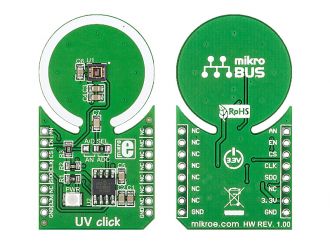
We strongly encourage users to use Package manager for sharing their code on Libstock website, because it boosts your efficiency and leaves the end user with no room for error. [more info]

Rating:
Author: MIKROE
Last Updated: 2018-11-07
Package Version: 1.0.0.1
mikroSDK Library: 1.0.0.0
Category: Optical
Downloaded: 7576 times
Followed by: 2 users
License: MIT license
With UV click you can measure Ultraviolet light intensity both indoors and outdoors. The photodiode on the ML8511 IC is sensitive to UV-A (365–315 nm) and UV-B (315-280) rays. You can use UV click to design devices that protect the user against excesive sun exposure, or for industrial purposes where UV light is used for sterilization.
Do you want to subscribe in order to receive notifications regarding "UV click" changes.
Do you want to unsubscribe in order to stop receiving notifications regarding "UV click" changes.
Do you want to report abuse regarding "UV click".
